 |
| Welcome to Gravity Falls. |
 |
||
| A cutie patootie. |
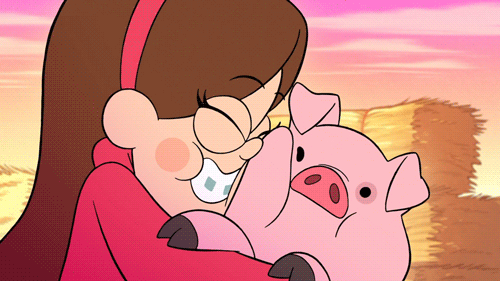 |
||
| Don’t worry Mabel, you really are so so charming. |
The radical notion that women like good movies
Figuring out who you are in the face of societal pressures that buffet you every which way is the trial of growing up, and helping people to do that is one of feminism’s goals. It’s also at the heart of ‘Gravity Falls’, which helps cement this for me as an exciting show.
 |
| Welcome to Gravity Falls. |
 |
||
| A cutie patootie. |
 |
||
| Don’t worry Mabel, you really are so so charming. |
‘Hey Arnold!’ taught life lessons without the viewer realizing it. An episode called “Stoop Kid” taught kids about the benefits of getting out of their comfort zone. The episode “Chocolate Boy” humorously analogized drug addiction. Arnold’s closeness with Gerald alongside Helga’s rapport with Phoebe highlighted the importance of friendship. The wrongness of first impressions was a reoccurring lesson; a dumb character would have moments of wisdom or a snobby character would have moments of vulnerability or a seemingly lucky rich kid would be shown as unhappy and/or overstressed. My favorite example of this message is in the episode “Ms. Perfect”, which introduced the character of Lila. Her popularity caused female students to envy her at first. But once they learned about Lila’s troubled life, the girls apologized and accepted her.
This guest post by Nia McRae appears as part of our theme week on Children’s Television.
Usually, urban life in movies and television is depicted in a bleak way. Growing up, I found myself confused by why the “norma” high school experience always took place in sunny suburbia. Often times, when school life in urban areas were depicted, it was… well, this:

Suffice it to say, it wasn’t an experience that I could relate to. The only depictions of city life that somewhat reflected my experience was the original movie, Fame (1980) and the cartoon, Hey Arnold! (1996). It may sound strange to call a cartoon relatable but HA! was unique in that way. It pushed the limits by showing the good, the bad and the ugly sides of urban life without reducing it to another story about poor and troubled minority youths in need of a white savior.
HA! revolved around the lives of fourth-graders attending PS. 118. It was a character-driven show that treated its child viewers like mature and intelligent people. Adult subject matters like addiction, muggings, family neglect, bullying, politics, war, complicated family dynamics, death, desire, gender identity, activism, capitalism, and many others were explored in an age-appropriate and usually humorous manner. All of the characters came from different walks of life. Arnold was the protagonist but he wasn’t the most interesting character per se. The most fascinating character was Helga G. Pataki. She was full of contradictions. Her tough girl attitude and sports activities would technically classify her as a “tomboy” and yet she had a traditionally feminine appearance (except for the unibrow). She was excessively hateful towards Arnold but only because she was secretly in love with him.
She still remains the most complex female character I’ve ever seen in a cartoon. Helga was a bully with a gentler side that she was too proud to show. She came across as a brute in public but in private, she was creative, cultured, and intelligent. Her multilayered characterization made people cheer for her as a character, especially in hopes of her someday becoming romantically involved with Arnold. The dynamic between Helga and Arnold subverted gender stereotypes. The cartoon gender-flipped the cliché of boys being mean to girls as a way of showing affection. She exhibited “masculine” traits of being rude, violent, and insensitive to others. She was also ambitious; in the episode “Married,” she dreamed of being president. Arnold, on the other hand, exhibited “feminine” qualities of being patient, empathetic, and supportive.

Helga had insecurities and anger issues due to her family life. Her dad, Bob was a self-absorbed blowhard who measured a person’s worth by accomplishments. Her mom, Miriam, was a dissatisfied and absentminded housewife. Her sister, Olga, was an overachiever who her parents constantly lavished with praise and attention. Helga was neglected by her family–a fact emphasized by her father’s continual habit of calling her by the wrong name. The episode “Helga on the Couch” revealed that when she and Arnold were toddlers, he was the first to give her positive attention. Because of her extreme loneliness, she responded to Arnold’s kindness with great intensity. The episode gave further insight into why Helga had what’s often viewed as the “masculine” problem of repressing her sensitive side due to the typical “male” fear of being ridiculed and seen as weak.
Despite having qualities associated with boys, Helga wasn’t immune to the pitfalls of being a girl in a patriarchal society. A lot of episodes revolved around her doing stupid things for a guy or being tempted to be more lady-like to please someone. She went above and beyond doing foolish things over Arnold whether it was sabotaging his date with a girl he liked named Lila in “Love and Cheese” or pretending to be very sophisticated in “Dinner for Four” or pretending to be Arnold’s French pen pal in “Arnold’s Valentine.” A lot of things that Helga did for Arnold’s attention were over-the-top for comedic effect. But an episode called “Helga’s Masquerade” was painfully realistic. In the episode, Helga mimicked Lila in fashion and behavior, hoping that Arnold’s affection for Lila would transfer to her.
After she basically turned herself into a carbon copy of Lila, Arnold started giving her the attention she desired. However, she became unsatisfied having changed herself to please him. By the end, she returned to being herself. Another episode that was very informative for young girls was “Helga’s Makeover”; Helga was left out of a sleepover party because she wasn’t girly enough. She conforms despite her best friend, Phoebe, telling her to be true to herself. Once she’s welcomed by the girls, she changes her mind. Its overall lesson was that there’s more than one way to be a girl.

I was a kid when I first saw these episodes, unaware of how closely Helga’s growing pains would mirror my life in terms of making a guy’s opinion of me way too important or struggling/clashing with expectations of what a girl is “supposed” to be.
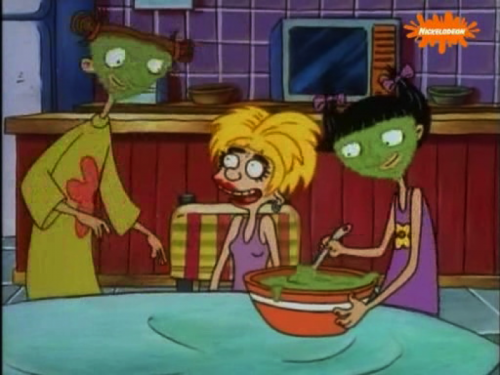
Arnold had personal struggles that also served as inspiration for young viewers. Arnold lived in a boardinghouse that his grandparents owned. He was usually the voice of reason but he sometimes made mistakes. In the episode, “Mugged,” he dealt with being mugged in the wrong way. He had to learn more than once to appreciate his nontraditional family. But overall, he was the embodiment of altruism and a great role model for kids. His tendency to go the extra mile in assisting people caused Gerald to frequently say to him, “You’re a bold kid, Arnold.” His selfless nature was unusual for a kid his age and it made him a target for bullies. Still, he was never self-conscious about being singled out nor was he insecure about his head’s football shape despite how much Helga teased him about it. This clued in the child audience member that it was okay to have physical features that differ from what is considered “normal.”
Just like city life, HA! exposed children to a lot of culture. It had episodes that lovingly and creatively gave its own twist on classic operas and plays. Cartoonish sound effects were balanced out with smooth jazz, making for an eclectic musical score that reflected the essence of the show. Additionally, the introduction of country music in episode “Mr. Hyunh Goes Country,” alongside other episodes that involved a Frank Sinatra-like character named Dino Spumoni, helped kids to develop an early appreciation of music. The refreshingly non-stereotypical Jewish character, Harold was probably the first introduction a lot of kids had to Yiddish words. The show normalized interracial couples; Helga’s best friend, Phoebe, was uneventfully shown to be the product of a white mother and Asian father. Also, she and Gerald–an African American–had brief moments of innocent flirtation throughout the series.

Most bully characters in cartoons are mean just for the sake of being mean. It makes them easy to dislike and dismiss as “bad.” Hey Arnold! didn’t make things easy. Characters that seemed scary were shown to be harmless up close. Harold had an imposing presence and boisterous voice. But his bark was always proven to be bigger than his bite because whenever someone stood up to him, he would cower and sometimes literally cry for his mommy. Helga thought Big Patty was dumb and mean but with Arnold’s help, she discovered Patty was actually reasonable, nice, and perceptive. Helga would be mean to Arnold in public but then hide to secretly profess her love for him and/or express her regret for hurting him. Oftentimes, characters that I thought I was supposed to despise would turn out to have a softer side. As a result, I would feel conflicted and eventually submit to having compassion for them.
The reason why seemingly despicable characters would inspire sympathy is because the show swayed the viewer to see the people from Arnold’s nonjudgmental perspective. There would be episodes that provided explanations, not excuses, for why a bully was mean in order to make children as understanding as Arnold. Helga was not an easy character to pin down and therefore, she challenged young viewers to see the areas of gray. Normally in fiction, a female school bully is reduced to being the catty pretty girl. But Helga’s power didn’t come from being pretty; it came from instilling fear into people with the threat of violence–an attribute that’s traditionally given to a male bully. What kept you from fully hating her is there being episodes that revolved around Helga’s home life that made you feel sorry for her and understand her better.
Hey Arnold! taught life lessons without the viewer realizing it. An episode called “Stoop Kid” taught kids about the benefits of getting out of their comfort zone. The episode “Chocolate Boy” humorously analogized drug addiction. Arnold’s closeness with Gerald alongside Helga’s rapport with Phoebe highlighted the importance of friendship. The wrongness of first impressions was a reoccurring lesson; a dumb character would have moments of wisdom or a snobby character would have moments of vulnerability or a seemingly lucky rich kid would be shown as unhappy and/or overstressed. My favorite example of this message is in the episode “Ms. Perfect,” which introduced the character of Lila. Her popularity caused female students to envy her at first. But once they learned about Lila’s troubled life, the girls apologized and accepted her.
The show also deconstructed the traditional definition of a happy and healthy family. Helga technically had a nuclear family yet they were dysfunctional. Arnold didn’t have a typical nuclear family yet he was emotionally healthy and stable. His parents died when he was young which was explained in the episode “Parents’ Day.” The show never glossed over the pain of losing a love one. There were scenes that showed his sadness and his longing to know more about his parents. The importance of an extended family and surrogate family was highlighted throughout the show; his kooky grandparents were his guardians and the offbeat boarders acted as surrogate relatives. Though the boarders had their funny quirks and various accents, it never went into the territory of caricature. Whatever flaw any character had was attributed to their individual personality, not their race or culture or gender.
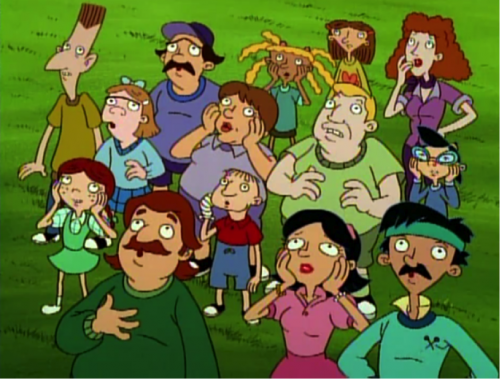
I applaud the show for never babying its audience. It had numerous Halloween episodes that I fondly remember being genuinely creepy. One of the most touching examples of its creative risk-taking is the episode “Arnold’s Christmas,” which revolved around Vietnamese tenant, Mr. Hyunh. He had to separate from his daughter during the Vietnam War to give her a better life. It’s still rare for me to see a show or movie that sympathizes with what ordinary Vietnamese people went through during the Vietnam War. Another episode that had the subject of war was “Veteran’s Day,” in which Grandpa reminisces about his experiences as a World War II veteran. But not all of Hey Arnold! episodes were profound; serious episodes would be balanced with lighthearted episodes like “Beaned,” “April Fool’s Day,” or “Stuck In A Tree,” as to not overburden the viewer.
Hey Arnold! was a show that celebrated diversity and encouraged children to do the same. Like Gargoyles or Batman: The Animated Series, it redefined what a cartoon could be by taking big chances. I’m still awed by the character development, witty dialogue and complicated subject matter it had. Just like Animaniacs, it’s a cartoon show that people can watch again as adults in order to understand the occasional subtle adult humor they overlooked as children. It had great representation when it came to race, gender, class and culture. It was one of the few shows that revealed the positive sides of living in the city, including the richness of knowing people from all walks of life. With humor and sensitivity, it challenged me intellectually and it instilled me with lessons that would be valuable in childhood and beyond.
Nia McRae graduated summa cum laude from Medgar Evers College where she earned a Bachelor of Arts degree in Liberal Studies with a concentration in history. She has a strong passion for critiquing racial and gender politics in the media and putting it in historical context.
What makes good television programming “for children” is elusive. No demographic is unanimous in its tastes, but children differ from one another more than other groups: what fascinates a 4-year-old can bore an 11-year-old and vice versa. Add to this problem that most critics and programming creators are not children themselves, and we can see why most children’s programming is so terrible: because it, even more than other types of art, is based on, to quote Jane Wagner “a collective hunch.” Still, like a Supreme Court justice famously said about pornography, most of us, even those of us who don’t have children, can recognize excellent children’s programming when we see it, like the 80s made-for-television ‘Anne of Green Gables,’ based on the book by Lucy Maud Montgomery.
Written by Ren Jender as part of our theme week on Children’s Television.
When I was a kid, in the 1970s, children’s television was…strange. As more than one person has pointed out many programs from that period–with their talking golden flutes, soft-rock singers who are part insect, part human and a bizarre underworld in a magician’s hat–seem to owe more to late 60s psychedelia than any common guidelines–besides the obvious ones that prohibit sex, swearing and gore. As critic Pauline Kael pointed out in a review of Chitty Chitty Bang Bang, a lot of films that are meant “for children” (including some Disney films) have scenes in them that leave their intended audience profoundly upset, like the death of Bambi’s mother or Dumbo’s mother (hmmm, another mother) chained and imprisoned. Kael recommended a list of films made for adults that were also appropriate for children because all too often films “for children” are the repository for acting that’s too awkward, plots that are too recycled, and scripts that are too terrible to pass muster with an adult audience.
What makes good television programming “for children” is similarly elusive. No demographic is unanimous in its tastes, but children differ from one another more than other groups: what fascinates a 4-year-old can bore an 11-year-old and vice versa. Add to this problem that most critics and programming creators are not children themselves, and we can see why most children’s programming is so terrible: because it, even more than other types of art, is based on, to quote Jane Wagner, “a collective hunch.” Still, like a Supreme Court justice famously said about pornography, most of us, even those of us who don’t have children, can recognize excellent children’s programming when we see it, like the 80s made-for-television Anne of Green Gables, based on the book by Lucy Maud Montgomery.
The title character (played to perfection by Megan Follows) is a girl (12 years old at the beginning) who is at turns dreamy, dramatic, exploited (as an orphan at the turn of the 20th century, her role in the households that “take her in” is often to care for many other younger children) and impetuous. She recites from books of poetry to get away from the drudgery of her everyday life and speaks to her own reflection in window panes to allay her loneliness. Although she encounters cruelty (as many other girl protagonists in literature, films and TV set in that era do, especially those who are orphans), her love of literature and her imagination have given her a combination of hopefulness and resilience not often seen in other girl characters.
The place where she finds what would now be called a “forever family” is an unlikely one–a small town on Prince Edward Island, Avonlea, in the title home of Marilla (Colleen Dewhurst) and Matthew (Richard Farnsworth) an unmarried brother-sister pair who are closer to the age of grandparents than most foster or adoptive parents would be. Originally they had requested from the orphanage a 13-year-old boy to help out on their farm, and when they see the orphanage has sent them a girl, plan to send her back. But loquacious Anne first charms Matthew, then stern Marilla (who is also reluctant to send Anne to another large family which seems intent on working her to death), so Anne stays for “a trial” that soon ends. She becomes a permanent member of the family.
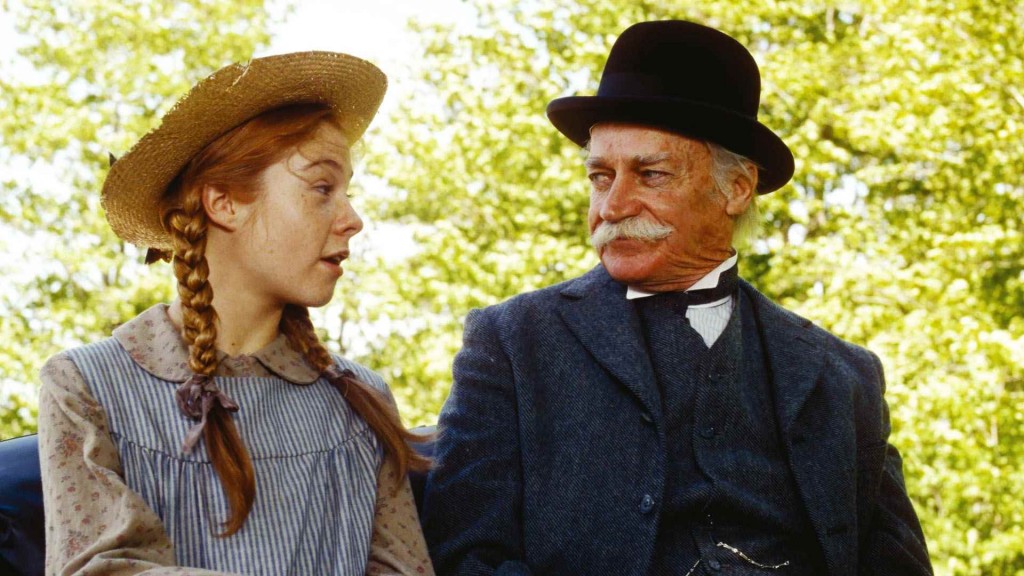
Dewhurst and Farnsworth were award-winning stage and movie stars in the latter part of their careers, but they don’t have the vanity in their parts that more contemporary stars would: their worn tan faces, with prominent cheekbones, make them look like the older, hard-working (though prosperous) denizens of a farmhouse that these characters are. And because they, along with Follows, are so skilled, they bring a resonance to their scenes, especially those where they show their love for Anne. Farnsworth is especially endearing in a scene at the general store when he postpones buying a party dress for Anne (an item which, as a bachelor farmer, he’s never bought before) by asking for twenty pounds of sugar. Anne never takes their name (her own last name is “Shirley”) and calls them by their first names, never “Mom and Dad” or even “Aunt and Uncle” but the three are very much a loving, if non-traditional family. When the pair see Anne off to a larger town so she can continue her education, Matthew tells Marilla how lucky they were that the orphanage sent them her instead of a boy, Marilla answers, “It wasn’t luck. It was providence. He knew we needed her.”
Although the book was first published in 1908, very close to the time it portrays the TV movie (which has the look of a theatrical release, full of beautiful Prince Edward Island vistas) doesn’t have the sexism that can mar the literature of the past. Everyone (even the town gossip) takes Anne’s education (and the accolades she wins for her studies) seriously, though, in keeping with the period, Diana (Schuyler Grant) Anne’s “bosom friend” who accurately predicts when they first meet, “we’re going to get along really well”, is not allowed to continue school past a sophomore high school level and is instead expected to learn how to keep house.

The other characters are very much of their time too, in their dress, their speech (Marilla, when Anne tells her she doesn’t know how to pray, later tells Matthew she’s a “heathen”) their wall-papered, quilted and curtained houses and unsullied landscapes. Green Gables never has the kind of careless anachronism that even programs that pride themselves on their period accuracy, like Mad Men, do.
Gilbert (Jonathan Crombie) the boy who will become Anne’s love interest (though not until the very end, and with no kissing, so children who hate love scenes are safe) teases her when they first meet, at the town’s one-room schoolhouse, calling her “Carrot” because of her red hair. But instead of giggling, pouting or crying (the go-to reactions for girls in literature, TV and movies) she breaks a slate (which the children write on instead of paper) over his head.

Both Anne and Diana are drawn to Gilbert, but they don’t compete for his attention, realizing their friendship is far too central to their lives to ruin for a boy, even in their small town where the selection of potential “beaus” is limited. Green Gables is full of observations about living in a small community (which can also apply to living in the super-small communities of family–or a relationship): often showing Anne finding affinities and support from characters (many of them women) who seem unlikely allies at first.

Gilbert, although he is often Anne’s main rival for prizes and scholarships at school still respects her intelligence: early in their acquaintance he is rumored to tell a friend, “smart is better than pretty.” But Anne, though she begins Green Gables in pigtails, a smock and a tattered straw hat becomes a poised Gibson girl and a teacher by the end, with a cameo at her neck and gloves on her hands, her hair worn “up”–both beautiful and smart.
(All stills accompanying this review are © Sullivan Entertainment)
[youtube_sc url=”http://www.youtube.com/watch?v=czJi_FpLBYY&feature=kp”]
___________________________________________________
Ren Jender is a queer writer-performer/producer putting a film together. Her writing besides appearing every week on Bitch Flicks has appeared in The Toast, xoJane and the Feminist Wire. You can follow her on Twitter @renjender.
‘Adventure Time’ is a Cartoon Network animated series that combines surrealistic comedy, fantasy and science-fiction. Based on a 2008 short by Pendleton Ward that went viral, it parodies the tropes, archetypes and cliches of fairy tales, video games and childhood action figure battles. The basic premise is about Finn, the last remaining human, and his best friend/adoptive brother Jake (a shape-shifting dog), going on your typical slay-the-monster-save-the-princess adventures. Now in its fourth season, it’s an enormous hit with all genders and age groups and shows no signs of slowing down. And let me tell you, as a feminist, why I am absolutely celebrating this show.
This repost by Myrna Waldron appears as part of our theme week on Children’s Television.
 |
| Title screen for Adventure Time |
Warning: Spoilers up to the end of Season 3
Adventure Time is a Cartoon Network animated series that combines surrealistic comedy, fantasy and science-fiction. Based on a 2008 short by Pendleton Ward that went viral, it parodies the tropes, archetypes and cliches of fairy tales, video games and childhood action figure battles. The basic premise is about Finn, the last remaining human, and his best friend/adoptive brother Jake (a shape-shifting dog), going on your typical slay-the-monster-save-the-princess adventures. Now in its fourth season, it’s an enormous hit with all genders and age groups and shows no signs of slowing down. And let me tell you, as a feminist, why I am absolutely celebrating this show.
 |
| The main cast of Adventure Time |
 |
| Jake stretching around the other main cast members |
 |
| Fionna and Cake |
 |
| Finn |
Myrna Waldron is a feminist writer/blogger with a particular emphasis on all things nerdy. She lives in Toronto and has studied English and Film at York University. Myrna has a particular interest in the animation medium, having written extensively on American, Canadian and Japanese animation. She also has a passion for Sci-Fi & Fantasy literature, pop culture literature such as cartoons/comics, and the gaming subculture. She maintains a personal collection of blog posts, rants, essays and musings at The Soapboxing Geek, and tweets with reckless pottymouthed abandon at @SoapboxingGeek.
Though the show’s focus on romantic love, fashion, and female rivalry are of dubious value, there are definitely a lot of good things going on with ‘Jem and the Holograms’: the notion that fame and fortune should be used for philanthropic means, that female friendships can be strong and form an important network of support, and that a sense of community is crucial.
This repost by Amanda Rodriguez appears as part of our theme week on Children’s Television.
As a little girl growing up in the 80s, I loved the show Jem and the Holograms. I confess that I still have a bunch of the songs from the show that I listen to from time to time (occasionally subjecting my spin class attendees to a Jem track on my workout playlists). Looking back now as an adult feminist, I’ve wondered how the show influenced me and whether or not that influence was a positive thing. *I did a similar assessment of another of my much-loved 80’s cartoons called: She-Ra Kinda Sorta Accidentally Feministy.*
There are a few potential not-necessarily-empowering aspects of Jem. Firstly, the show is fashion-obsessed and revolves around the characters’ fashionability. Unlike most cartoons where the characters mostly wear the same outfit in every episode, the thin female bodies of Jem‘s characters are adorned in multiple wardrobe changes often within a single 20-minute episode. Fashion and modeling, we know, are traditionally coded as female. The fashion world is extremely hard on women, placing undue emphasis on their bodies, especially on the thinness of those bodies. The drummer (and Black bandmate) Shana, however, designs clothing, so there is an aspect of fun creative expression at play here. Not only that, but the band Jem and the Holograms gets into the world of fashion and music in order to maintain the foster home for young girls that they run.
In this light, being on the cutting-edge of fashion, making money, being famous, and maintaining their record label (Starlight Music) is all a means to a philanthropic ends. The band often performs benefit concerts, singing many songs that deliver a positive message about fair play, hard work, creativity, education, and friendship to its young, predominately female audience. Jerrica Benton (Jem’s alter ego) must become a savvy business woman in the advent of her father’s death in order to run her inherited huge record label while living with her beloved foster girls, trying to give them good, happy lives. Jerrica and her friends are capable, ambitious women who thrive in the business world and do so for noble reasons. That type of female representation is all too rare in any pop culture medium, and it definitely had a positive effect on my impressionable younger self.
Another aspect of the show that could be a negative for little girls was all the female rivalry. The primary focus of the show was the often high-stakes band rivalry between Jem and the Holograms and their nemeses (another all-female band), The Misfits.

The Misfits were mean, reckless, and ruthless in their pursuit to beat Jem at everything. They’d lie, cheat, commit crimes and sabotage, and endanger the lives of Jem and her bandmates in order to win at any cost. They even had a song called “Winning is Everything.” True story.
[youtube_sc url=”http://www.youtube.com/watch?v=CMlneySmI3g”]
Though Jem passes the Bechdel Test with flying colors, this dangerous female rivalry is troubling, reinforcing mainstream media’s insistence that women can’t be friends; they must, instead, compete for resources, men, and general approval. Instead of the bands being able to cooperate and collaborate, they are mostly at each other’s throats (with The Misfits, of course, being the instigators). The upside of this rivalry is that the major players are all women. The characters with all the talent, power, and agency are women. The epitome of this is the all-powerful matriarchal figure of Synergy. She’s a basically sentient hologram generating computer system. She gets Jem and her crew out of countless jams, operates as home base for their operations, and acts as a concerned, maternal mentor for them. Though Synergy is a computer system, she has awesome power and Jerrica/Jem often goes to her for counsel.
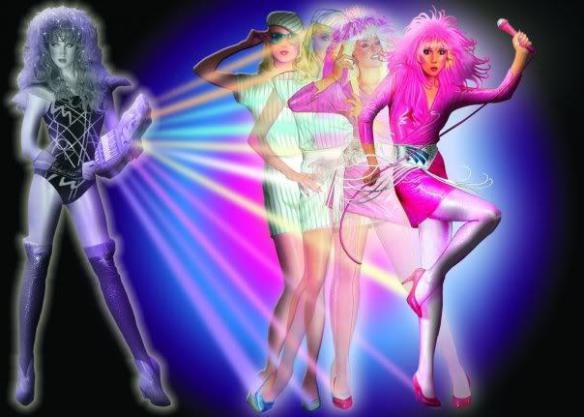
Not only that, but even the cruel Misfits are given depth over time. My favorite character (on whom I had a serious girl-crush) was Stormer, the blue-haired Misfit who was a bad girl with a heart of gold. When her bandmates crossed the line, she would always undermine their machinations in order to do the right thing, often saving the day. We also learn that Pizazz, the ringleader and front woman for the band, struggles with her former identity as: Phyllis, a rich girl with a neglectful father whose approval and attentiveness she could never garner. Despite the contentiousness of the rival bands’ relations, the fact that women are the primary actors and reactors gives the show a variety of female perspectives and permutations, which is what’s so often lacking in current female representations in film and on TV.
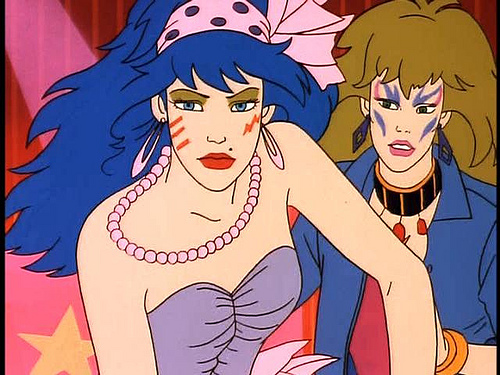
In fact, there are hardly any male characters in the show at all. There are only two to speak of: Jem/Jerrica’s love interest and road manager, Rio Pacheco, and The Misfits’ slimy band manager, Eric Raymond. Later the lead singer of The Stingers, Riot, enters the scene with his ridiculous hair and obsession with Jem. These male characters’ relevance and even usefulness was often in question. Eric was incompetent at all of his scheming in a distinctly Road Runner style. Jem/Jerrica couldn’t even confide her secrets in Rio, and he was often left waiting in the dark for situational resolutions. I often questioned how healthy for young girls the representation of the love triangle involving Rio, Jem, and Jerrica was. It was bizarre that Jem was Jerrica, so Rio was essentially cheating on his girlfriend…with his girlfriend. There was even an episode where Jerrica gets tired of being herself and her Jem personae, so she dons a hologram of a completely new appearance. Rio falls in love with her, too, and they share a kiss. Though the inherent deception on all sides of the relationship is not good role modeling, maybe it’s important that Rio loves Jerrica no matter what physical form she takes on.

The band itself, Jem and the Holograms, was also surprisingly racially diverse. The drummer, Shana, was Black, and the lead guitarist, Aja, was Asian. They later added a new drummer, Raya, who was Latina, when Shana took up bass guitar. Though the front woman for the band (who couldn’t actually play an instrument) remained a white woman, with the addition of Raya, there were actually more women of color in the band than white women. I don’t know if I’ve ever seen that kind of ratio on a TV show that wasn’t specifically targeted at people of color.

Though the show’s focus on romantic love, fashion, and female rivalry are of dubious value, there are definitely a lot of good things going on with Jem and the Holograms: the notion that fame and fortune should be used for philanthropic means, that female friendships can be strong and form an important network of support, that a sense of community is crucial, especially that of an older generation of women actively participating in that of teenage girls, that the arts should be respected and fostered, and that the virtues women should value in themselves should include honesty, compassion, fairness, determination, and kindness. Maybe I’m biased because I always thought the show was “truly outrageous,” but the good seems to outweigh the bad, giving us a series about women that tried to teach little girls how to grow up to be strong, ethical, and believe in themselves.
Bitch Flicks writer and editor Amanda Rodriguez is an environmental activist living in Asheville, North Carolina. She holds a BA from Antioch College in Yellow Springs, Ohio and an MFA in fiction writing from Queens University in Charlotte, NC. She writes all about food and drinking games on her blog Booze and Baking. Fun fact: while living in Kyoto, Japan, her house was attacked by monkeys.
For those who don’t know, ‘Jessie’ is a Disney Channel series about a girl from Texas who moves to New York City and becomes nanny for a Brangelina couple with four adopted children from around the world. If done well, it could allow for very educational programming for children about diversity and identity. Spoiler alert: it hasn’t been done well. It’s been done terribly.

This cross-post by Katherine Filaseta appears as part of our theme week on Children’s Television and previously appeared at her blog Complaining About Things I Like.
For those who don’t know, Jessie is a Disney Channel series about a girl from Texas who moves to New York City and becomes nanny for a Brangelina couple with four adopted children from around the world. If done well, it could allow for very educational programming for children about diversity and identity. Spoiler alert: it hasn’t been done well. It’s been done terribly.
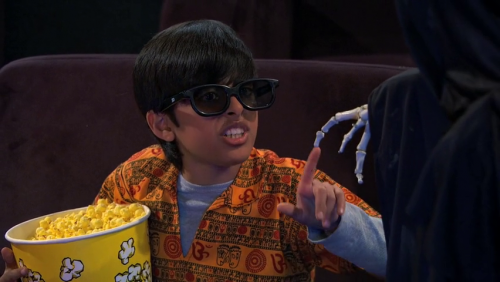
Ravi is the newest addition to the family, recently adopted from India. He brought with him his water monitor (Mr. Kipling), whom he met as a baby. He talks with an exaggerated accent and is constantly referencing Ganesh, samosas, tigers, non-violence, fortune telling, and curry – to name a few. He teaches a yoga class and wears sherwanis.
This entire character is straight out of Edward Said’s Orientalism. Essentially, orientalism is when Westerners lump the entire continent of Asia into one foreign land with which they can associate everything they don’t understand. Things from this exotic land are instantly mystical and weird, because orientalists don’t understand them. This is okay, because orientalists prefer things to be unknown and mysterious and magical. As one of my professors put it: Bizarre Foods with Andrew Zimmern is orientalism; Anthony Bourdain’s No Reservations is not. Jessie is orientalism.
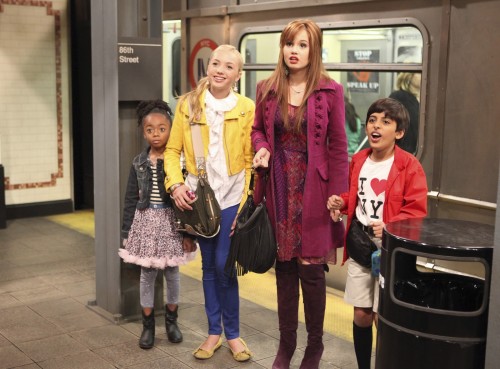
The idea that Ravi found a random lizard egg and decided to be best friends with it is one example of the orientalism used in this show. India does have a lot of wildlife, but it isn’t quite teeming with exotic creatures – one issue in India right now is how to protect the few tigers left on the planet, all of which live in India, mostly under precarious conditions. Especially since globalization, India is not really the image we have in our heads from Disney’s The Jungle Book, even though Disney is perpetuating this misconception through Ravi and Mr(s). Kipling’s friendship. We’re also exaggerating the influence Rudyard Kipling actually had on India. He traveled there a few times over a century ago; I’m pretty sure a random kid off the streets of India wouldn’t be naming his pet after him.
More importantly, even a “fresh off the boat” 8-year-old Indian kid who had not previously been exposed to American culture would not say things like “great Ganesh!” This isn’t a thing I have ever heard an Indian person say. I also don’t know any Indians who are constantly consulting their crystal balls and other magical ancient devices. A majority of the stereotypes Ravi embodies in the show aren’t even real stereotypes of India, so I really don’t understand why they are so prevalent. Also, how did an 8-year-old get certified to teach yoga? Is this also just because he is Indian?
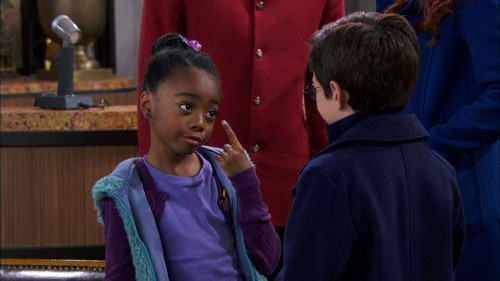
Zuri was apparently adopted from Africa as a baby and raised by an upper-class white family. However, her catch phrases are things like “mmmmhmmmm” and “oh no you didn’t,” both said in a very stereotypically Black way. She also has a major attitude problem that the adults never address, probably because they just assume all Black people act that way.
The worst part about her character to me is that not just the stereotypes, but the fact that she is exhibiting urban Black stereotypes despite never having been a part of urban Black society. She lives in an Upper East Side penthouse and was born in Uganda. It is reminiscent of early 20th century ideas: things like social darwinism. These characteristics of Zuri exist in her genetics just because of the color of her skin.
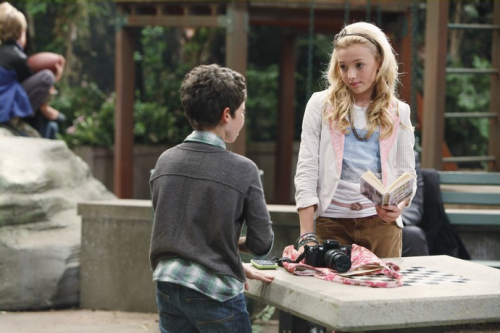
Emma and Luke are the two white children in the family. Emma is a typical “dumb blonde”; all she appears to be able to think about is boys, fashion, glitter, and celebrity gossip. She is constantly making ditzy comments and screaming high-pitched screams because she broke a nail. Luke is just a typical “boy,” which means he is always hitting on girls and using sexual innuendos. The sexual innuendos in themselves are in my opinion inappropriate for a children’s show; even if the target audience for these innuendos is parents, the children are the ones saying them. It isn’t just the innuendos in themselves, however – it’s that Luke’s character is perpetuating this idea that making degrading comments about girls’ bodies is okay, because it is just a “thing boys do.” Despite societal expectations, pretty blonde girls can care about more than looking good, and boys don’t have to constantly treat girls like objects.
The least offensive stereotype in this show is of Jessie. Since she’s from Texas, her dad is in the military and taught her how to shoot a gun when she was 5 years old. She also is always talking about how great Texas is. Typical Texan…
Recently, Disney Channel aired the worst episode of this show yet: “To Be or Not to Be.” In it, every character ends up switching bodies (a la Freaky Friday). If anyone had been watching the show and somehow didn’t realize how offensive all the stereotypes were, this episode makes it even more blatantly obvious. Jessie gets to put on a “Black girl” accent (I didn’t even know there was a “Black girl” accent?), and the butler does a terrible imitation of an Indian accent (think Ashton Kutcher Popchips ad, but worse). Wholesome Disney fun with hilarious racial stereotypes!
Edit: It just got even better. The new episode that aired 19 April 2013 has a women’s singer-songwriter show that Jessie is invited to perform at. Apparently the only people who would ever go to support aspiring female artists are other women – specifically, women who don’t shave their legs, hate all men, and wear ‘sensible shoes’. Hey, Jessie! You don’t have to hate men and fashion to be supportive of women. In fact, you can even be a man! And/or wear high heels!
Katherine Filaseta is a recent graduate of Washington University in Saint Louis, who is currently living and working with kids in New York. She really likes Bollywood, education, feminism, the performing arts, and apparently children’s TV. Follow her on twitter and wordpress.
This has been a post I’ve been meaning to write for a long time. I’m an absolutely die-hard fan of ‘Sailor Moon,’ and part of that is because it served as my childhood introduction to feminism. That might be a little bit hard to believe, considering the superheroines of the show are known for outfits not much more revealing than Wonder Woman’s. Silly outfits aside (you get used to them), this show was absolutely groundbreaking. Its protagonists are 10 realistically flawed, individual and talented teenage girls (and women) who, oh, you know. Save the world.
 |
| Sailor Moon characters |
This repost by Myrna Waldron appears as part of our theme week on Children’s Television.
This has been a post I’ve been meaning to write for a long time. I’m an absolutely die-hard fan of Sailor Moon, and part of that is because it served as my childhood introduction to feminism. That might be a little bit hard to believe, considering the superheroines of the show are known for outfits not much more revealing than Wonder Woman’s. Silly outfits aside (you get used to them), this show was absolutely groundbreaking. Its protagonists are 10 realistically flawed, individual and talented teenage girls (and women) who, oh, you know. Save the world.
 Sailor Moon/Usagi Tsukino:
Sailor Moon/Usagi Tsukino: Sailor Mercury/Ami Mizuno:
Sailor Mercury/Ami Mizuno:
 Sailor Mars/Rei Hino:
Sailor Mars/Rei Hino:
 Sailor Venus/Minako Aino:
Sailor Venus/Minako Aino: Sailor Chibi-Moon/Chibiusa Tsukino:
Sailor Chibi-Moon/Chibiusa Tsukino: Sailor Pluto/Setsuna Meioh:
Sailor Pluto/Setsuna Meioh: Sailor Uranus/Haruka Tenoh:
Sailor Uranus/Haruka Tenoh:
 Sailor Neptune/Michiru Kaioh:
Sailor Neptune/Michiru Kaioh:
Original source for the character images borrowed from Manga Style!.
Myrna Waldron is a 25-year-old pop culture fanatic with a special passion for animation. She can be reached on Twitter at @SoapboxingGeek, where she muses openly about whatever strikes her fancy.
In our culture, where children now watch an average of 35 hours of television per week, much of that formative information that children are rapidly absorbing and storing comes from TV. We must, therefore, consider what kind of programming we’re offering to these hugely malleable young people. What kind of messages are we sharing with our children? Are we giving them lessons of acceptance, diversity, and cooperation? Are we teaching them vital critical thinking skills? Or are we, instead, feeding them gender roles, racial hierarchy, and the centrality of the nuclear family?
Our theme week for June 2014 will be Children’s Television
They say children are like sponges for a reason. It turns out that a “child has already developed half of his total adult intellectual capacity by the time he is four years old and 80 percent of it by age eight.” This fact lays bare how critical it is for children to be exposed to expansive, quality learning experiences. In fact, neurobiologist at Baylor College of Medicine Dr. Martha Pierson says, “Children need a flood of information, a banquet, a feast.” In our culture, where children now watch an average of 35 hours of television per week, much of the formative information that children are rapidly absorbing and storing comes from TV.
In our capitalist society, many corporations see children as just another demographic with the power to influence their parents to buy toys. Around the 70s, many children’s TV shows became little more than advertisements for products, such that the FCC mandated children’s programming contain some educational content, which inspired the oft derided, tacked-on PSA (public service announcement) at the end of episodes to meet that regulation. This ruling was struck down in the 90s, so now we must rely on the questionable intentions of the corporations who produce children’s media to provide programming that enriches the lives and expands the brains of children.
Ultimately, we must consider what kind of programming we’re offering to these hugely malleable young people. What kind of messages are we sharing with our children? Are we giving them lessons of acceptance, diversity, and cooperation? Are we teaching them vital critical thinking skills? Or are we, instead, feeding them gender roles, racial hierarchy, and the centrality of the nuclear family? What kind of people, what kind of citizens will these children grow up to be?
We’d like you to examine children’s television shows, analyzing what role they play in the feminist movement as well as the general upbringing of children. Feel free to use the examples below to inspire your writing on this subject, or choose your own source material.
We’d like to avoid as much overlap as possible for this theme, so get your proposals in early if you know which film you’d like to write about. We accept both original pieces and cross-posts, and we respond to queries within a week.
Most of our pieces are between 1,000 and 2,000 words, and include links and images. Please send your piece as a Microsoft Word document to btchflcks[at]gmail[dot]com, including links to all images, and include a 2- to 3-sentence bio.
If you have written for us before, please indicate that in your proposal, and if not, send a writing sample if possible.
Please be familiar with our publication and look over recent and popular posts to get an idea of Bitch Flicks’ style and purpose. We encourage writers to use our search function to see if your topic has been written about before, and link when appropriate (hyperlinks to sources are welcome, as well).
The final due date for these submissions is Friday, June 20 by midnight.
Barney & Friends
Teletubbies
Kim Possible
Hannah Montana
Jem & the Holograms
G.I. Joe
He-Man
She-Ra
Adventure Time
Dora the Explorer
Blue’s Clues
My Little Pony
Pokémon
Sponge Bob
Power Rangers
Reading Rainbow
Powerpuff Girls
Scooby-D00
Fraggle Rock
Mister Rogers’ Neighborhood
Sesame Street
Teenage Mutant Ninja Turtles